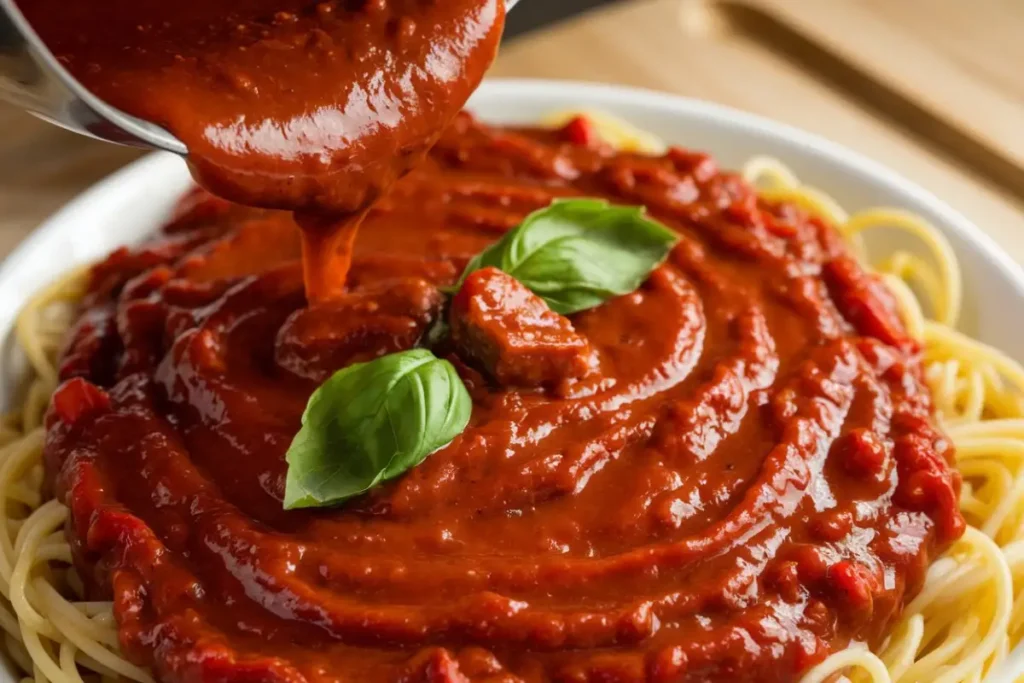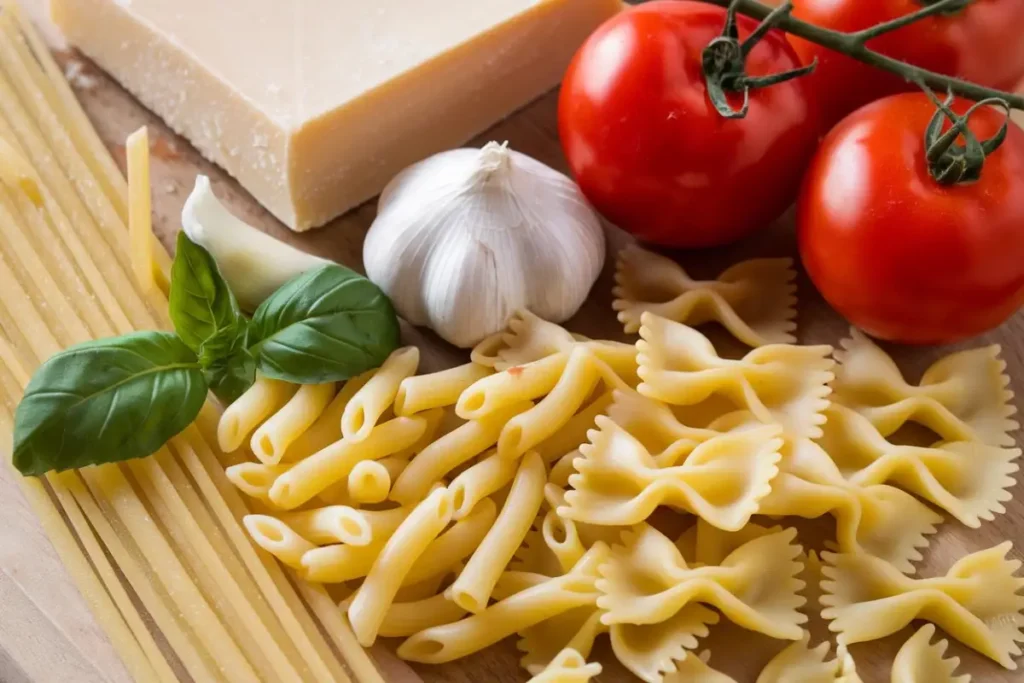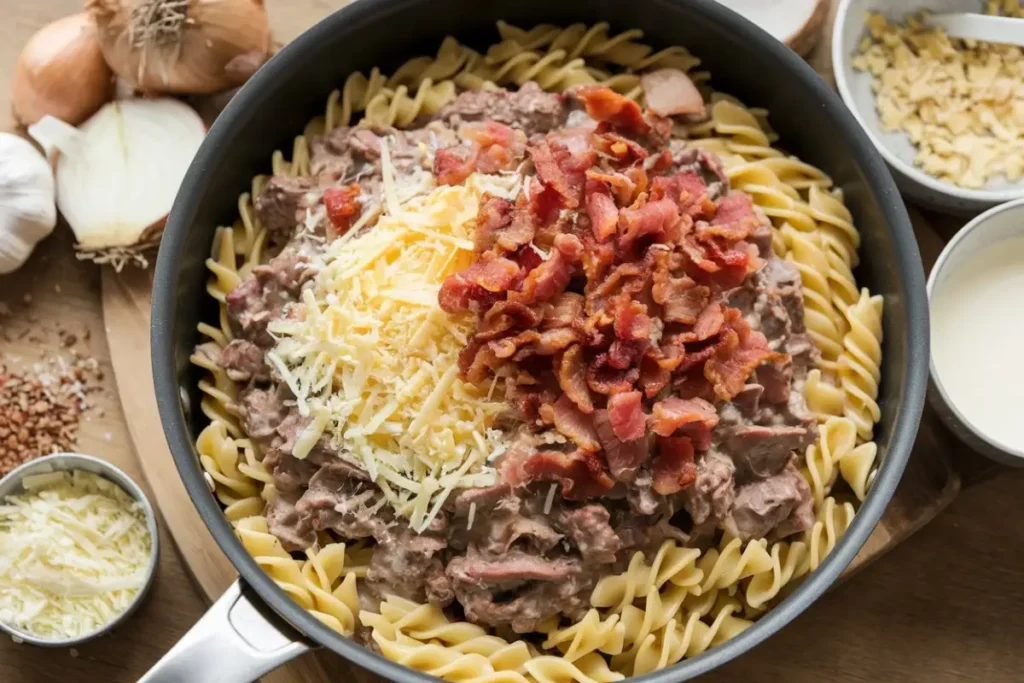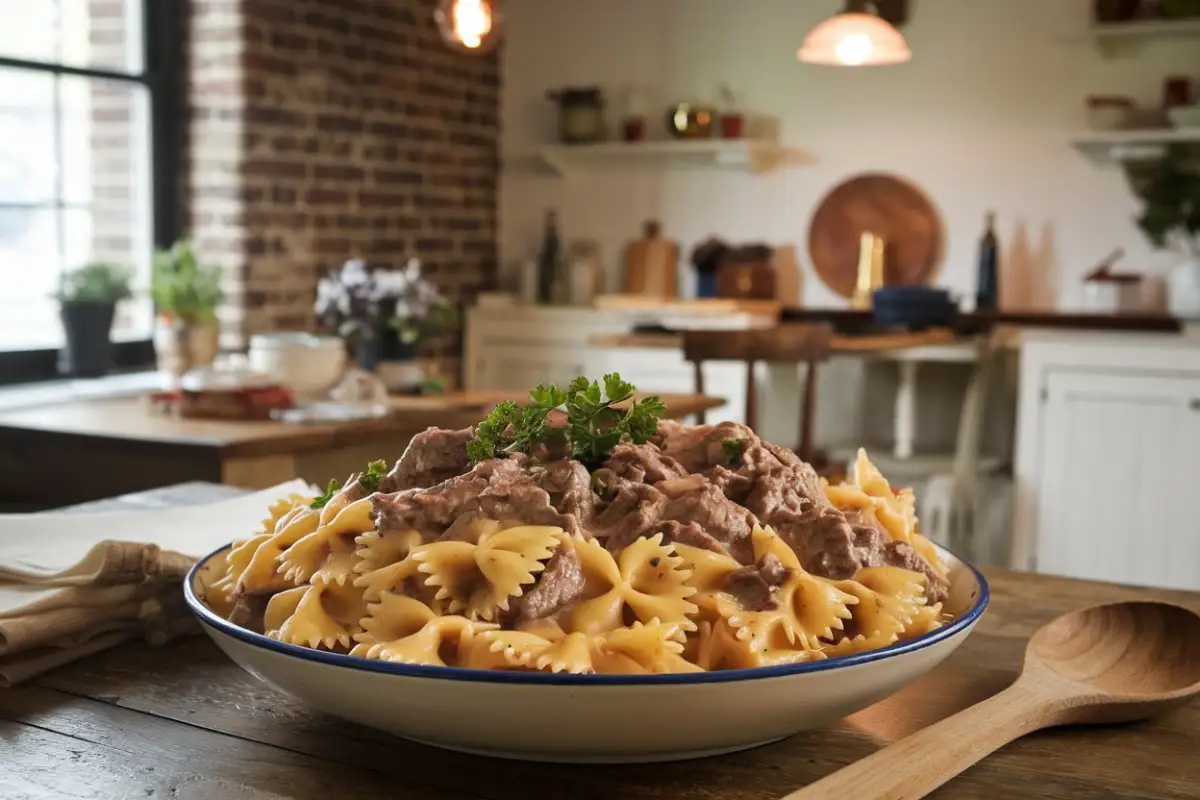Let’s be honest who can resist a delicious pasta dish? When you combine tender, flavorful beef, perfectly cooked bowtie pasta, and a rich, creamy sauce, you get more than just a meal you get a comforting, crave-worthy experience. Creamy Beef and Bowtie Pasta isn’t just food; it’s that familiar hug on a chilly day, the dish everyone goes back for at potlucks, and the one you secretly dream about midweek. But what makes it so irresistible? It’s that perfect fusion of textures and flavors: the al dente bite of the pasta, the savory depth of the beef, and the luscious creaminess that makes every forkful feel like home.
Now, picture this: you’ve had a long, exhausting day, and the last thing you want is a complicated dinner. That’s where this dish shines. It’s quick, customizable, and uses pantry staples you likely already have. And if you want to explore even more comforting pasta options, check out these 5 Secrets to the Best Italian Cream Cake Recipe or get inspired by the authentic techniques in 10 Secrets to Making Authentic Italian Pasta. This recipe is more than a meal it’s your reliable, delicious go-to that never disappoints.
Beyond Basic: What Makes This Dish So Appealing?
So, what elevates this dish from just “good” to “OMG, this is amazing!”? It’s a combination of factors, really. First, there’s the texture. You’ve got the slight resistance of the al dente bowtie pasta, the tender, juicy beef, and the smooth, velvety sauce coating every single bite. It’s a symphony of textures that keeps your palate interested. Then, there’s the flavor. The savory beef, balanced with the richness of the cream and cheese, and the bright notes of herbs and spices… It’s a flavor explosion that hits all the right notes. It’s not just about one dominant taste; it’s about the harmony of all the ingredients working together.
But perhaps the most significant appeal is its versatility. This isn’t a rigid, inflexible recipe. You can easily adapt it to your preferences and what you have on hand. Don’t have bowtie pasta? Use penne or rotini. Prefer ground turkey to beef? Go for it! Want to add some veggies? Throw in some spinach or mushrooms. The possibilities are endless! It’s a blank canvas for your culinary creativity. Think of it as a framework – a solid base upon which you can build your own masterpiece.
“Cooking is like love. It should be entered into with abandon or not at all.” – Harriet Van Horne
A History of Beef and Pasta: From Italy to Your Table
While Creamy Beef and Bowtie Pasta isn’t exactly a traditional Italian dish (the creamy sauce leans more towards American interpretations of Italian-American cuisine), it’s still interesting to consider the history of its key components. Pasta, of course, has a long and storied history in Italy, dating back centuries. Different shapes and sizes evolved over time, each suited to different sauces and preparations. Bowtie pasta, also known as farfalle, is a relatively modern shape, but its playful form makes it a popular choice.
Beef, on the other hand, has been a staple in diets around the world for millennia. In Italy, beef is often used in hearty ragus and braised dishes. The combination of beef and pasta is a natural pairing, providing a satisfying and protein-rich meal. However, the creamy sauce that defines our dish is where things get a little less traditional. Cream-based sauces aren’t as common in classic Italian cuisine as tomato-based or olive oil-based sauces. The creamy element likely evolved from American adaptations of Italian recipes, catering to a preference for richer, more decadent flavors.
Essentially, Creamy Beef and Bowtie Pasta is a delightful fusion of Italian and American culinary influences. It takes the best of both worlds the comforting simplicity of pasta and beef, and the indulgent creaminess that many of us crave. It’s a testament to how food evolves and adapts across cultures, creating new and exciting dishes that become beloved staples in their own right.
The Secret to the Perfect Creamy Sauce

Alright, let’s get down to business. The creamy sauce is the heart and soul of this dish. Nail the sauce, and you’ve already won half the battle. But achieving that perfect balance of richness, flavor, and consistency can be tricky. So, what’s the secret? It’s all about the right ingredients, the right technique, and a little bit of patience. Don’t rush the process; let the flavors meld and develop.
Choosing the Right Dairy: A Guide to Creaminess
First, let’s talk dairy. You have options here, and the choice you make will significantly impact the final result. Heavy cream is the classic choice for a truly decadent sauce. It’s rich, thick, and provides that luxurious mouthfeel we all love. However, it’s also the highest in fat. If you’re looking for a slightly lighter option, you can use half-and-half. It will still provide creaminess, but with fewer calories.
Another option is to use a combination of milk and cream cheese. This will give you a thick and tangy sauce that’s incredibly flavorful. Just make sure to use full-fat cream cheese for the best results. And if you’re feeling adventurous, you can even incorporate a little bit of sour cream for an extra layer of tanginess.
Ultimately, the best dairy choice depends on your preferences and dietary needs. Experiment with different combinations until you find the perfect balance of creaminess and flavor. Remember, the key is to use high-quality ingredients.
The Importance of Flavor: Building Depth in Your Sauce
A creamy sauce without flavor is just… bland. So, how do you build depth and complexity? It starts with the aromatics. Sautéing garlic and onions in butter or olive oil is the foundation of most great sauces. These humble ingredients release their fragrant oils, infusing the sauce with a subtle sweetness and savory depth.
Next, consider adding some herbs and spices. Fresh herbs like parsley, basil, and thyme can brighten the flavor and add a touch of freshness. Dried herbs like oregano and Italian seasoning can provide a more robust and earthy flavor. A pinch of red pepper flakes can add a subtle kick of heat. And don’t forget salt and pepper! Seasoning is crucial for bringing out the flavors of all the other ingredients.
“You don’t have to cook fancy or complicated masterpieces – just good food from fresh ingredients.” – Julia Child
Common Mistakes to Avoid: Cream Sauce Fails and How to Fix Them
Cream sauces can be finicky. They can curdle, separate, or just end up tasting… wrong. So, let’s talk about some common mistakes and how to avoid them.
- Curdling: This happens when the dairy proteins coagulate and separate. To prevent curdling, avoid boiling the sauce. Keep the heat low and slow, and add the dairy gradually. If the sauce does curdle, try whisking in a tablespoon of cold water or a splash of lemon juice.
- Separation: This is similar to curdling, but it’s less severe. The sauce might look oily or greasy. To prevent separation, use full-fat dairy and avoid overheating the sauce. If the sauce separates, try whisking it vigorously until it comes back together.
- Blandness: This is the most common problem. The sauce just doesn’t have enough flavor. To fix it, add more aromatics, herbs, and spices. A squeeze of lemon juice or a splash of white wine can also brighten the flavor.
Ingredient Spotlight: Elevating Your Beef and Bowtie Pasta

While the creamy sauce steals the spotlight (and rightfully so!), the other ingredients play equally vital roles in creating a truly unforgettable dish. Let’s delve into the specifics of choosing the right beef, pasta, cheese, herbs, and spices to elevate your Creamy Beef and Bowtie Pasta to the next level. Think of it as assembling a superhero team each member has their own unique skill set, and together they form an unstoppable force of flavor!
Selecting the Best Beef: From Ground Beef to Steak Bites
The type of beef you choose will significantly impact the flavor and texture of your dish. Ground beef is the most common and budget-friendly option. Lean ground beef (90/10) is a good choice if you’re looking to reduce the fat content, but remember that it can be drier than ground beef with a higher fat percentage (80/20). If you opt for leaner ground beef, be sure not to overcook it, and consider adding a splash of olive oil to the pan to keep it moist.
For a more decadent and flavorful option, consider using steak bites. Cut sirloin, ribeye, or even flank steak into small, bite-sized pieces and sear them quickly over high heat. This will create a beautiful crust and lock in the juices. Just be careful not to overcrowd the pan, as this will steam the beef instead of searing it. Searing in batches is the key!
Regardless of the type of beef you choose, be sure to season it generously with salt, pepper, and any other spices you like. A little garlic powder, onion powder, or smoked paprika can add depth and complexity.
Bowtie Pasta: Why the Shape Matters (and Alternatives)
Bowtie pasta, also known as farfalle, is the classic choice for this dish. Its unique shape allows it to capture the creamy sauce perfectly, creating a delightful textural contrast. The ruffled edges also add visual appeal. But what if you don’t have bowtie pasta on hand? Don’t worry! There are plenty of suitable alternatives.
Penne pasta is a great option. Its cylindrical shape and ridged surface also hold sauce well. Rotini, with its spiral shape, is another good choice. And if you’re looking for something a little different, try cavatappi (corkscrew pasta) or campanelle (bellflower pasta).
Ultimately, the best pasta shape is the one you enjoy the most. Don’t be afraid to experiment and find your favorite. Just make sure to cook the pasta al dente, which means “to the tooth” in Italian. It should be firm to the bite, not mushy. Overcooked pasta will fall apart and become gluey in the sauce.
Cheese, Herbs, and Spices: The Flavor Enhancers You Need
Cheese is an essential component of the creamy sauce. Parmesan cheese is a classic choice, adding a salty, nutty, and umami-rich flavor. Grate it finely for the best results. You can also use other hard cheeses like Pecorino Romano or Grana Padano.
For a creamier and meltier cheese, consider adding a touch of mozzarella or provolone. These cheeses will add a gooey, stretchy texture to the sauce. Just don’t overdo it, as too much mozzarella can make the sauce stringy.
Fresh herbs are a must for brightening the flavor of the dish. Parsley, basil, and thyme are all excellent choices. Chop them finely and add them at the end of cooking to preserve their flavor and aroma. A sprinkle of fresh herbs can elevate the dish from good to gourmet.
Spices can add depth, warmth, and complexity to the sauce. Garlic powder, onion powder, smoked paprika, and red pepper flakes are all great options. Experiment with different combinations to find your favorite blend.
“One of the great pleasures of life is food: cooking it, sharing it, and eating it.” – Guy Fieri
Step-by-Step Guide to Creamy Beef and Bowtie Perfection

Okay, now that we’ve covered the ingredients, let’s get cooking! Here’s a detailed, step-by-step guide to making Creamy Beef and Bowtie Pasta that will impress your family and friends. Consider this your culinary roadmap follow it closely, and you’ll reach your destination: a plate piled high with deliciousness.
Preparing the Beef: Searing, Browning, and Seasoning Tips
- Season the beef: Generously season your ground beef or steak bites with salt, pepper, garlic powder, onion powder, and any other spices you like.
- Heat the pan: Heat a large skillet or Dutch oven over medium-high heat. Add a tablespoon of olive oil or butter.
- Brown the beef: If using ground beef, add it to the pan and break it up with a spoon. Cook until browned, about 5-7 minutes. Drain off any excess grease. If using steak bites, sear them in batches until browned on all sides, about 2-3 minutes per side.
- Remove the beef: Remove the beef from the pan and set aside.
Cooking the Pasta: Al Dente is Key!
- Bring water to a boil: Fill a large pot with water and bring it to a rolling boil. Add a generous amount of salt. The water should taste like the sea! This will help season the pasta from the inside out.
- Cook the pasta: Add the bowtie pasta to the boiling water and cook according to package directions, until al dente.
- Drain and reserve pasta water: Drain the pasta in a colander, reserving about 1 cup of the pasta water. The starchy pasta water will help thicken the sauce and create a better emulsion.
Building the Creamy Sauce: A Detailed Walkthrough
- Sauté the aromatics: In the same skillet or Dutch oven, melt butter or olive oil over medium heat. Add minced garlic and chopped onions and sauté until softened and fragrant, about 3-5 minutes.
- Add flour (optional): For a thicker sauce, whisk in a tablespoon of all-purpose flour and cook for 1-2 minutes to create a roux. This will help thicken the sauce and prevent it from separating.
- Add liquid: Gradually whisk in chicken broth or vegetable broth, scraping up any browned bits from the bottom of the pan.
- Simmer: Bring the sauce to a simmer and cook for 5-7 minutes, or until slightly thickened.
- Add dairy: Reduce the heat to low and stir in heavy cream, half-and-half, or cream cheese.
- Add cheese and seasonings: Stir in grated Parmesan cheese, mozzarella cheese (if using), and any additional herbs and spices. Season with salt and pepper to taste.
- Simmer gently: Simmer the sauce over low heat for 5-10 minutes, or until the cheese is melted and the sauce is smooth and creamy.
Combining Everything: The Art of Emulsification
- Add the beef and pasta: Add the cooked beef and pasta to the sauce and toss to coat.
- Adjust consistency: If the sauce is too thick, add a little pasta water to thin it out. If the sauce is too thin, simmer it for a few more minutes to reduce it.
- Serve: Serve immediately, garnished with fresh parsley, grated Parmesan cheese, and a sprinkle of red pepper flakes (if desired).
Common Problems and Solutions: Troubleshooting Your Creamy Beef and Bowtie Pasta
Even with the most detailed instructions, things can sometimes go awry in the kitchen. Don’t panic! Most common problems with Creamy Beef and Bowtie Pasta are easily fixable. Let’s address some of the most frequent issues and their solutions. Consider this your culinary emergency kit everything you need to handle unexpected situations and emerge victorious!
Problem: Sauce is Too Thin
A thin sauce can be disappointing, as it won’t cling to the pasta properly. But don’t worry, there are several ways to thicken it up.
Solution: Cornstarch Slurry or Reduction
- Cornstarch Slurry: Mix 1 tablespoon of cornstarch with 2 tablespoons of cold water to create a slurry. Gradually whisk the slurry into the simmering sauce. Continue to simmer until the sauce thickens, about 1-2 minutes. Be careful not to add too much cornstarch, as it can make the sauce gloppy.
- Reduction: Simmer the sauce over low heat for a longer period, allowing the excess liquid to evaporate. This will concentrate the flavors and thicken the sauce naturally. Be sure to stir frequently to prevent the sauce from sticking to the bottom of the pan.
Problem: Sauce is Too Thick
A sauce that’s too thick can be equally problematic, making the pasta heavy and cloying. Fortunately, this is an easy fix.
Solution: Add Pasta Water or Broth
Gradually add small amounts of the reserved pasta water or chicken broth to the sauce, stirring until it reaches your desired consistency. The pasta water is especially effective because it contains starch, which will help emulsify the sauce and create a smooth, velvety texture.
Problem: Beef is Tough
Tough beef can ruin the entire dish. To avoid this, choose the right cut of beef and cook it properly.
Solution: Tenderizing Techniques and Choosing the Right Cut
- Choose the right cut: As mentioned earlier, steak bites made from tender cuts like sirloin or ribeye are less likely to be tough than ground beef.
- Tenderize: If using a less tender cut of beef, you can tenderize it by pounding it with a meat mallet before cooking.
- Marinate: Marinating the beef in an acidic marinade (containing vinegar, lemon juice, or wine) can also help to break down the muscle fibers and make it more tender.
- Don’t overcook: Overcooking the beef will make it dry and tough. Cook it until it’s just browned on the outside and still slightly pink on the inside (if using steak bites).
Problem: Sauce is Bland
A bland sauce is a common complaint, but it’s easily remedied with a few simple adjustments.
Solution: Adjust Seasoning, Add Umami-Rich Ingredients
- Adjust seasoning: Taste the sauce and add more salt, pepper, garlic powder, onion powder, or any other spices you like.
- Add umami-rich ingredients: Umami is a savory, meaty flavor that can add depth and complexity to the sauce. Ingredients like soy sauce, Worcestershire sauce, mushroom powder, or tomato paste are all excellent sources of umami.
- Add a splash of acid: A squeeze of lemon juice or a splash of white wine can brighten the flavor of the sauce and balance the richness.
Problem: Pasta is Overcooked/Mushy
Overcooked pasta is a textural disaster. To prevent this, follow the package directions carefully and cook the pasta al dente.
Solution: Accurate Cooking Time, Salted Water
- Accurate cooking time: Start checking the pasta for doneness a few minutes before the recommended cooking time.
- Salted water: As mentioned earlier, salting the pasta water not only seasons the pasta from the inside out, but also helps to prevent it from becoming mushy.
Flavor Variations: Customize Your Creamy Beef and Bowtie Pasta
One of the best things about Creamy Beef and Bowtie Pasta is its versatility. Don’t be afraid to experiment and customize the recipe to your liking. Here are a few flavor variations to get you started. Think of these as inspiration points springboards for your own culinary adventures!
Italian-Inspired: Adding Marinara and Italian Herbs
Add a jar of your favorite marinara sauce to the creamy sauce for a richer, more tomatoey flavor. Use Italian herbs like oregano, basil, and thyme.
Mexican-Inspired: Spicy Beef and Cheesy Sauce
Season the beef with chili powder, cumin, and smoked paprika. Add a can of diced tomatoes and green chiles to the sauce. Use a blend of cheddar and Monterey Jack cheese. Top with chopped cilantro and a dollop of sour cream.
Mushroom Lovers: Elevate with Wild Mushrooms and Truffle Oil
Sauté sliced mushrooms (cremini, shiitake, or oyster mushrooms) with the garlic and onions. Add a drizzle of truffle oil to the sauce at the end of cooking.
Vegetarian Option: Swapping Beef for Plant-Based Alternatives
Substitute the beef with plant-based ground meat crumbles or sautéed mushrooms. Use vegetable broth instead of chicken broth.
Serving Suggestions and Pairing Ideas
Creamy Beef and Bowtie Pasta is a hearty and satisfying meal on its own, but it can be even better when paired with the right side dishes and beverages.
Complementary Side Dishes: Salads, Bread, and Vegetables
- Salad: A simple green salad with a vinaigrette dressing can provide a refreshing contrast to the richness of the pasta.
- Bread: Crusty bread, garlic bread, or breadsticks are perfect for soaking up the creamy sauce.
- Vegetables: Roasted vegetables like broccoli, asparagus, or Brussels sprouts can add a healthy and flavorful element to the meal.
Wine Pairing: Finding the Perfect Complement
- Red Wine: A light-bodied red wine like Pinot Noir or Beaujolais can complement the richness of the dish without overpowering it.
- White Wine: A dry white wine like Sauvignon Blanc or Pinot Grigio can also be a good choice.
Garnishing and Presentation: Making it Look as Good as it Tastes
Garnish the dish with fresh parsley, grated Parmesan cheese, and a sprinkle of red pepper flakes (if desired). Arrange the pasta artfully on the plate and serve immediately.
Make-Ahead Tips and Storage Instructions
Creamy Beef and Bowtie Pasta is a great make-ahead dish. You can prepare the beef and sauce in advance and store them separately in the refrigerator.
Preparing Components in Advance: Save Time on Busy Weeknights
Cook the beef and prepare the sauce up to 2 days in advance. Store them separately in airtight containers in the refrigerator. Cook the pasta just before serving.
Proper Storage: Keeping Your Pasta Fresh
Store leftover pasta in an airtight container in the refrigerator for up to 3 days.
Reheating Instructions: Avoiding a Mushy Mess
Reheat the pasta in a skillet over medium heat, adding a little water or broth to prevent it from drying out. You can also reheat it in the microwave, but be careful not to overcook it.
Nutritional Information and Dietary Considerations
The nutritional information for Creamy Beef and Bowtie Pasta will vary depending on the specific ingredients used.
Calorie Count and Macronutrient Breakdown
A typical serving of Creamy Beef and Bowtie Pasta contains approximately 500-700 calories, 30-40 grams of fat, 40-50 grams of carbohydrates, and 25-35 grams of protein.
Gluten-Free Options: Adapting the Recipe for Dietary Needs
To make this dish gluten-free, use gluten-free pasta and ensure that all other ingredients are gluten-free.
Lower-Fat Alternatives: Making Healthier Choices
To reduce the fat content of the dish, use lean ground beef or ground turkey, half-and-half instead of heavy cream, and low-fat cheese.
Beyond the Recipe: Creative Uses for Leftovers
Don’t let those leftovers go to waste! Here are a few creative ways to use them up.
Beef and Bowtie Pasta Bake
Combine the leftover pasta with ricotta cheese, mozzarella cheese, and a beaten egg. Bake in a casserole dish until bubbly and golden brown.
Creamy Beef and Bowtie Pasta Frittata
Whisk eggs with milk and Parmesan cheese. Stir in the leftover pasta. Pour into a skillet and cook over low heat until set.
Stuffed Bell Peppers with Beef and Bowtie Filling
Hollow out bell peppers and fill them with the leftover pasta. Bake in the oven until the peppers are tender.
Recap of Key Tips and Techniques
Remember the key to success: Use high-quality ingredients, don’t overcook the pasta, and season generously.
Encouragement to Experiment and Make it Your Own
Don’t be afraid to experiment and customize the recipe to your liking. The possibilities are endless!
For more recipes Follow me in Facebook and Pinterest
FAQ: Answering Your Burning Questions About Creamy Beef and Bowtie Pasta
Can I use a different type of pasta?
Yes, penne, rotini, and cavatappi are all good alternatives.
Can I freeze this dish?
Yes, but the sauce may separate slightly upon thawing.
What other vegetables can I add?
Spinach, mushrooms, and peas are all great additions.
How can I make this recipe spicier?
Add more red pepper flakes or a pinch of cayenne pepper.
Is it possible to make this dish vegan?
Yes, use plant-based ground meat crumbles, vegan cream cheese, and nutritional yeast instead of Parmesan cheese.
Call to Action: Your Creations!
Encourage Readers to Leave Comments and Reviews
I’d love to hear about your experiences with this recipe! Please leave a comment and let me know how it turned out.
Conclusion: Your Journey to Creamy Beef and Bowtie Mastery
Congratulations! You’ve reached the end of this comprehensive guide to Creamy Beef and Bowtie Pasta. You now have all the knowledge and skills you need to create a truly unforgettable dish.

